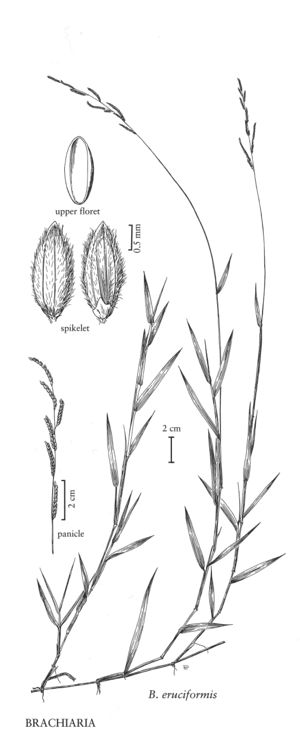Moorochloa eruciformis
Plants mat-forming. Culms (10)19-60 cm, decumbent, rooting at the lower nodes before geniculately ascending, sometimes branching from the upper nodes; nodes pubescent; internodes glabrous. Sheaths glabrous or pubescent; ligules to 1 mm; blades 2-6(12) cm long, 3-6 mm wide, pubescent (rarely pilose) on both surfaces, bases subcordate. Panicles 4-9 cm long, 0.5-1 cm wide, exserted, with 3-15 erect to appressed branches; branches 1-2 cm, hispidulous; pedicels 0.1-0.5 mm, pubescent. Spikelets (1.6)2-2.6 mm long, 0.8-1 mm wide, ovate. Lower glumes 0.3-0.5 mm, to 1/5 the spikelet length; upper glumes (1.6)2-2.5 mm; lower lemmas longer than the paleas, 5-veined, without cross-venation; upper lemmas (1.4)1.7-1.8 mm long, 0.6-0.9 mm wide; anthers 0.5-1 mm, reddish. Caryopses 1-1.5 mm. 2n = 18, 36.
Discussion
Moorochloa eruciformis is native from the Mediterranean to tropical Africa and India. It tends to be a weedy species in many parts of the world, growing in moist, disturbed sites. It has been grown for evaluation as a forage crop at various experimental stations in the United States. A few of these plantings have resulted in escapes that have persisted persisted for a short time, but the species has not become an established in the Flora region.
Selected References
None.
